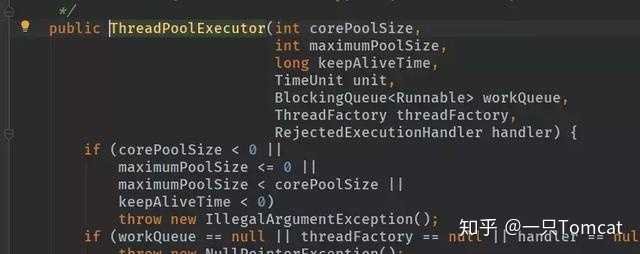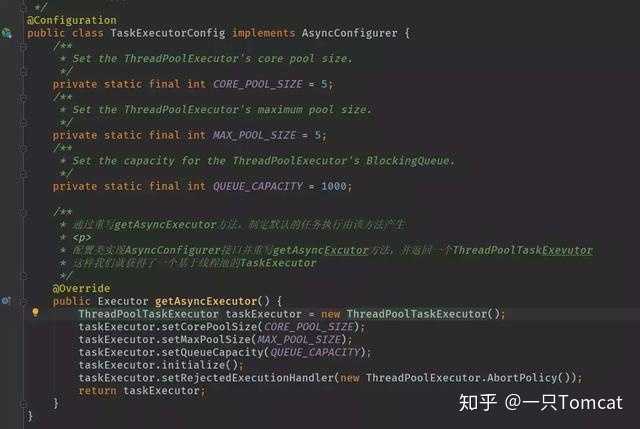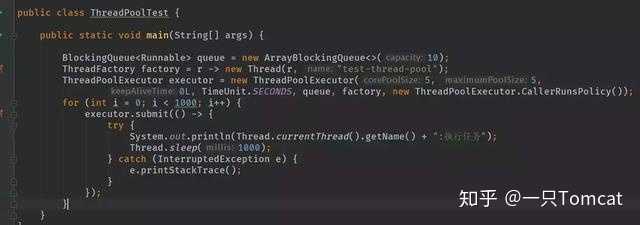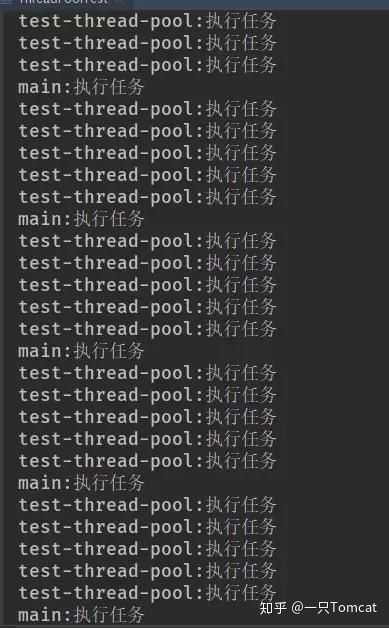一、前言
线程池,相信很多人都有用过,没用过相信的也有学习过。但是,线程池的拒绝策略,相信知道的人会少许多。
二、四种线程池拒绝策略
当线程池的任务缓存队列已满并且线程池中的线程数目达到maximumPoolSize时,如果还有任务到来就会采取任务拒绝策略,通常有以下四种策略:
ThreadPoolExecutor.AbortPolicy:丢弃任务并抛出RejectedExecutionException异常。 ThreadPoolExecutor.DiscardPolicy:丢弃任务,但是不抛出异常。 ThreadPoolExecutor.DiscardOldestPolicy:丢弃队列最前面的任务,然后重新提交被拒绝的任务 ThreadPoolExecutor.CallerRunsPolicy:由调用线程(提交任务的线程)处理该任务
三、线程池默认的拒绝策略
既然有四种拒绝策略可以选择,那么线程池的默认拒绝策略是什么呢?查看
java.util.concurrent.ThreadPoolExecutor类的源码,我们可以看到:
/**
* The default rejected execution handler
*/
private static final RejectedExecutionHandler defaultHandler =
new AbortPolicy();线程池的默认拒绝策略为AbortPolicy,即丢弃任务并抛出RejectedExecutionException异常。我们可以通过代码来验证这一点,现有如下代码:
public class ThreadPoolTest {
public static void main(String[] args) {
BlockingQueue<Runnable> queue = new ArrayBlockingQueue<>(100);
ThreadFactory factory = r -> new Thread(r, “test-thread-pool”);
ThreadPoolExecutor executor = new ThreadPoolExecutor(5, 5,
0L, TimeUnit.SECONDS, queue, factory);
while (true) {
executor.submit(() -> {
try {
System.out.println(queue.size());
Thread.sleep(10000);
} catch (InterruptedException e) {
e.printStackTrace();
}
});
}
}
}
这里是一个默认的线程池,没有设置拒绝策略,设置了最大线程队列是100。运行代码:
结果是符合预期的,这也证明了线程池的默认拒绝策略是ThreadPoolExecutor.AbortPolicy:丢弃任务并抛出RejectedExecutionException异常。
四、设置线程池拒绝策略
如果我们想要根据实际业务场景需要,设置其他的线程池拒绝策略,可以通过ThreadPoolExecutor重载的构造方法进行设置:
现在的开发中,相信大家都有使用spring,其实我们也可以通过spring提供的org.springframework.scheduling.concurrent.ThreadPoolTaskExecutor构建线程池。如下:
@Configuration
public class TaskExecutorConfig implements AsyncConfigurer {
/**
* Set the ThreadPoolExecutor’s core pool size.
*/
private static final int CORE_POOL_SIZE = 5;
/**
* Set the ThreadPoolExecutor’s maximum pool size.
*/
private static final int MAX_POOL_SIZE = 5;
/**
* Set the capacity for the ThreadPoolExecutor’s BlockingQueue.
*/
private static final int QUEUE_CAPACITY = 1000;
/**
* 通过重写getAsyncExecutor方法,制定默认的任务执行由该方法产生
* <p>
* 配置类实现AsyncConfigurer接口并重写getAsyncExcutor方法,并返回一个ThreadPoolTaskExevutor
* 这样我们就获得了一个基于线程池的TaskExecutor
*/
@Override
public Executor getAsyncExecutor() {
ThreadPoolTaskExecutor taskExecutor = new ThreadPoolTaskExecutor();
taskExecutor.setCorePoolSize(CORE_POOL_SIZE);
taskExecutor.setMaxPoolSize(MAX_POOL_SIZE);
taskExecutor.setQueueCapacity(QUEUE_CAPACITY);
taskExecutor.initialize();
taskExecutor.setRejectedExecutionHandler(new ThreadPoolExecutor.AbortPolicy());
return taskExecutor;
}
}
五、拒绝策略场景分析
(1)AbortPolicy
AbortPolicy
ThreadPoolExecutor.AbortPolicy:丢弃任务并抛出RejectedExecutionException异常。
A handler for rejected tasks that throws a {@code RejectedExecutionException}.这是线程池默认的拒绝策略,在任务不能再提交的时候,抛出异常,及时反馈程序运行状态。如果是比较关键的业务,推荐使用此拒绝策略,这样子在系统不能承载更大的并发量的时候,能够及时的通过异常发现。
(2)DiscardPolicy
ThreadPoolExecutor.DiscardPolicy:丢弃任务,但是不抛出异常。如果线程队列已满,则后续提交的任务都会被丢弃,且是静默丢弃。
A handler for rejected tasks that silently discards therejected task.
使用此策略,可能会使我们无法发现系统的异常状态。建议是一些无关紧要的业务采用此策略。例如,本人的博客网站统计阅读量就是采用的这种拒绝策略。
(3)DiscardOldestPolicy
ThreadPoolExecutor.DiscardOldestPolicy:丢弃队列最前面的任务,然后重新提交被拒绝的任务。
A handler for rejected tasks that discards the oldest unhandled request and then retries {@code execute}, unless the executor is shut down, in which case the task is discarded.此拒绝策略,是一种喜新厌旧的拒绝策略。是否要采用此种拒绝策略,还得根据实际业务是否允许丢弃老任务来认真衡量。
(4)CallerRunsPolicy
ThreadPoolExecutor.CallerRunsPolicy:由调用线程处理该任务
A handler for rejected tasks that runs the rejected task directly in the calling thread of the {@code execute} method, unless the executor has been shut down, in which case the task is discarded.
如果任务被拒绝了,则由调用线程(提交任务的线程)直接执行此任务,我们可以通过代码来验证这一点:
把之前的代码修改如下:
public static void main(String[] args) {
BlockingQueue<Runnable> queue = new ArrayBlockingQueue<>(10);
ThreadFactory factory = r -> new Thread(r, "test-thread-pool");
ThreadPoolExecutor executor = new ThreadPoolExecutor(5, 5,
0L, TimeUnit.SECONDS, queue, factory, new ThreadPoolExecutor.CallerRunsPolicy());
for (int i = 0; i < 1000; i++) {
executor.submit(() -> {
try {
System.out.println(Thread.currentThread().getName() + ":执行任务");
Thread.sleep(1000);
} catch (InterruptedException e) {
e.printStackTrace();
}
});
}
}
把队列最大值改为10,打印输出线程的名称。执行结果如下:
通过结果可以看到,主线程main也执行了任务,这正说明了此拒绝策略由调用线程(提交任务的线程)直接执行被丢弃的任务的。
六、总结
本文介绍和演示了四种线程池拒绝策略,具体使用哪种策略,还得根据实际业务场景才能做出抉择。
今天的文章线程池4个拒绝策略_超线程技术开启还是关闭分享到此就结束了,感谢您的阅读。
版权声明:本文内容由互联网用户自发贡献,该文观点仅代表作者本人。本站仅提供信息存储空间服务,不拥有所有权,不承担相关法律责任。如发现本站有涉嫌侵权/违法违规的内容, 请发送邮件至 举报,一经查实,本站将立刻删除。
如需转载请保留出处:https://bianchenghao.cn/74692.html





